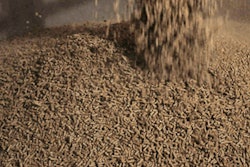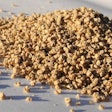The first four months of 2009 saw demand for feed in Brazil contract by 5.9 percent in comparison with the same period of 2008. In comparison with the last four months of 2008, the situation was even worse, reports feed association Sindiraceos, demand was some 15 percent lower.
But this contraction should not be taken in isolation and, in some respects, is to be, in part, expected.
The feed market is seasonal, with the January-April period being the weakest of the year. On top of this, Brazil, like any other country, is suffering as a result of the global financial crisis. While faring better than many - during the first quarter, Brazil’s GDP contracted by only 0.8 percent - the same cannot always be said for some of its trading partners.
What has raised concern, however, is that the contraction in poultry feed production has been greater than that for feed output as a whole. Difficulties in the sector have been headline grabbing, with reports of producers halting production due to a lack of credit and farmers running out of supplies to feed their birds leading to thousands dying.
With broiler feed now accounting for some 46 percent of total Brazilian production and feed for layers accounting for a further 8 percent, fluctuations in the feed industry could be seen as a pretty good barometer of what is happening in the poultry industry as a whole.
Between January and April this year, demand for broiler feed fell by 9 percent in comparison to the same period last year. This contraction was largely the result of declining chick placements. In October last year, chick placements stood at 496 million head, but by February, the figure had fallen to 406 million head.
So where does this contraction leave the Brazilian poultry and feed industries? Does it signify the start of a decline, or at best, stagnation, in a sector that has witnessed spectacular growth over recent years, or is this simply a temporary blip? Despite production of chicken meat during the first four months of the year falling by 13% in comparison with the previous four months, the latter, is almost certainly the case.
Long-term outlook
It we consider the home market alone, Brazil is continuing to see a population drift from the countryside to towns, rising living standards and growing demand for animal protein. Economic reform has meant that inflation has been brought under control and real living standards are rising.
And Brazil’s living standards are forecast to continue rising, even if the current economic crisis may have hampered this somewhat. As far as the poultry industry is concerned, this means that chicken will be served in Brazilian households with increasing frequency and demand will grow for value added products.
According to studies carried out by the Organization for Economic Co-operation and Development (OECD) and the Food and Agriculture Organization (FAO), over the next 10 years, Brazilian poultry production (all species) will reach 17.7 million tons, an increase of 52.21 percent on 2008 estimates.
Over the same period, the joint study estimates that the home market wil grow by 49%, while exports will rise by 58%.
While the long-term outlook remains positive, what about the short term?
Short term
Late last year it was predicted that total demand for poultry feed would increase by 4.1% this year, with strongest growth occurring in layer feed, up by 5 percent, while demand for broiler feed is expected to grow by 4 percent.
Figures for the first few months of this year do not necessarily contradict this forecast.
The price of chicken in Brazil tends to be at its weakest during the first quarter of each year. Unusually, however, prices for live birds in the country during the first quarter of this year were some 25% higher than during the first quarter of 2008. While the market may be relatively fragile the collapse that many had feared has not occurred. Importantly, by April chick placements had risen again to 456 million, with a consequent upturn in demand for feed.
According to Carlos Cogo Consultoria Agroeconomica, it is still possible that Brazil’s poultry exports this year will reach the same levels as those achieved last year. Certainly, volumes during the first quarter would suggest this having fallen only slightly short of those exported last year. Indeed, exports of unprocessed chicken were slightly higher. By value, however, exports during the first quarter were significantly lower, and ended the quarter 23% lower.
Nevertheless, Brazil is continuing to enter new markets, and total poultry exports should grow by a maximum of 5% this year, according to Brazilian Chicken Producers and Exporters Association (Abef), although some exporters believe that it will hard to reach this figure.







